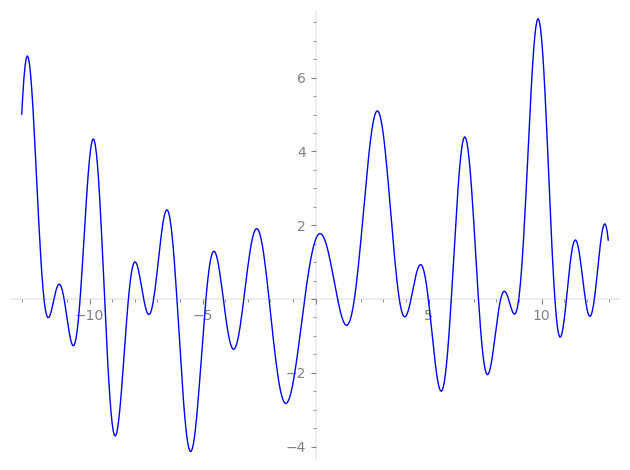| L(s) = 1 | + (−15.2 + 15.2i)5-s + 24.4·7-s + (20.1 + 20.1i)11-s + (26.7 − 26.7i)13-s − 85.9i·17-s + (−53.2 − 53.2i)19-s + 119. i·23-s − 337. i·25-s + (−78.5 − 78.5i)29-s − 200. i·31-s + (−372. + 372. i)35-s + (76.9 + 76.9i)37-s − 279.·41-s + (−15.7 + 15.7i)43-s + 470.·47-s + ⋯ |
| L(s) = 1 | + (−1.36 + 1.36i)5-s + 1.32·7-s + (0.553 + 0.553i)11-s + (0.571 − 0.571i)13-s − 1.22i·17-s + (−0.643 − 0.643i)19-s + 1.08i·23-s − 2.69i·25-s + (−0.502 − 0.502i)29-s − 1.16i·31-s + (−1.79 + 1.79i)35-s + (0.342 + 0.342i)37-s − 1.06·41-s + (−0.0559 + 0.0559i)43-s + 1.46·47-s + ⋯ |
\[\begin{aligned}\Lambda(s)=\mathstrut & 1152 ^{s/2} \, \Gamma_{\C}(s) \, L(s)\cr =\mathstrut & (0.888 + 0.458i)\, \overline{\Lambda}(4-s) \end{aligned}\]
\[\begin{aligned}\Lambda(s)=\mathstrut & 1152 ^{s/2} \, \Gamma_{\C}(s+3/2) \, L(s)\cr =\mathstrut & (0.888 + 0.458i)\, \overline{\Lambda}(1-s) \end{aligned}\]
Particular Values
| \(L(2)\) |
\(\approx\) |
\(1.609855720\) |
| \(L(\frac12)\) |
\(\approx\) |
\(1.609855720\) |
| \(L(\frac{5}{2})\) |
|
not available |
| \(L(1)\) |
|
not available |
\(L(s) = \displaystyle \prod_{p} F_p(p^{-s})^{-1} \)
| $p$ | $F_p(T)$ |
|---|
| bad | 2 | \( 1 \) |
| 3 | \( 1 \) |
| good | 5 | \( 1 + (15.2 - 15.2i)T - 125iT^{2} \) |
| 7 | \( 1 - 24.4T + 343T^{2} \) |
| 11 | \( 1 + (-20.1 - 20.1i)T + 1.33e3iT^{2} \) |
| 13 | \( 1 + (-26.7 + 26.7i)T - 2.19e3iT^{2} \) |
| 17 | \( 1 + 85.9iT - 4.91e3T^{2} \) |
| 19 | \( 1 + (53.2 + 53.2i)T + 6.85e3iT^{2} \) |
| 23 | \( 1 - 119. iT - 1.21e4T^{2} \) |
| 29 | \( 1 + (78.5 + 78.5i)T + 2.43e4iT^{2} \) |
| 31 | \( 1 + 200. iT - 2.97e4T^{2} \) |
| 37 | \( 1 + (-76.9 - 76.9i)T + 5.06e4iT^{2} \) |
| 41 | \( 1 + 279.T + 6.89e4T^{2} \) |
| 43 | \( 1 + (15.7 - 15.7i)T - 7.95e4iT^{2} \) |
| 47 | \( 1 - 470.T + 1.03e5T^{2} \) |
| 53 | \( 1 + (-112. + 112. i)T - 1.48e5iT^{2} \) |
| 59 | \( 1 + (241. + 241. i)T + 2.05e5iT^{2} \) |
| 61 | \( 1 + (6.00 - 6.00i)T - 2.26e5iT^{2} \) |
| 67 | \( 1 + (273. + 273. i)T + 3.00e5iT^{2} \) |
| 71 | \( 1 + 448. iT - 3.57e5T^{2} \) |
| 73 | \( 1 + 54.7iT - 3.89e5T^{2} \) |
| 79 | \( 1 - 29.1iT - 4.93e5T^{2} \) |
| 83 | \( 1 + (-893. + 893. i)T - 5.71e5iT^{2} \) |
| 89 | \( 1 + 281.T + 7.04e5T^{2} \) |
| 97 | \( 1 - 188.T + 9.12e5T^{2} \) |
| show more | |
| show less | |
\(L(s) = \displaystyle\prod_p \ \prod_{j=1}^{2} (1 - \alpha_{j,p}\, p^{-s})^{-1}\)
Imaginary part of the first few zeros on the critical line
−9.331781029643938217093941177345, −8.280306891940406222978229043322, −7.60292198423394446099663017176, −7.16365298892635702633245961007, −6.13368226911150773566973940738, −4.85133272852088522084246367793, −4.08105022089827652772899989832, −3.17427177931676202870145896936, −2.05762537542030553041584555329, −0.48161554560026414204515325838,
0.974348069947086184912089064533, 1.71682187183149770881729408752, 3.70412140646340635190686902083, 4.22261794932553472618770127087, 4.98857268820425793133750704335, 6.00444366765961887921566621526, 7.20687545483440139040442176838, 8.191547501151032632337511758877, 8.536068491594335090633736907032, 8.989420390905668989116006399362

